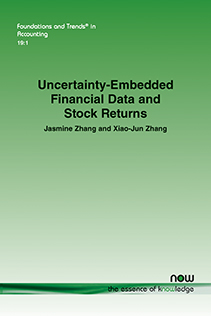Uncertainty-Embedded Financial Data and Stock Returns
By Jasmine Zhang, School of Information, University of California, Berkeley, USA, jasmine.zhang22@berkeley.edu | Xiao-Jun Zhang, Haas School of Business, University of California, Berkeley, USA, xiaojun.zhang@berkeley.edu
Abstract
This monograph investigates the role of conservative accounting in capturing various types of uncertainty in a firm’s operations and assesses how the resulting financial data can be harnessed to gauge risk and forecast stock returns. It challenges the conventional approach of employing cross-sectional return regression for empirically identifying financial ratios as “risk factors,” suggesting this methodology is fundamentally unsound. An accounting measure may help estimate the expected stock return of a firm, but it does not necessarily reflect any inherent risk in the firm’s operations. The study differentiates between conditional and unconditional conservative accounting practices, highlighting how they capture different facets of uncertainty and thereby lead to varying relationships between financial data and expected stock returns. The monograph further substantiates its claims with empirical evidence based on dissecting the market-to-book premium according to the accounting principles employed.
Uncertainty-Embedded Financial Data and Stock Returns
Uncertainty-Embedded Financial Data and Stock Returns investigates the role of conservative accounting in capturing various types of uncertainty in a firm's operations and assesses how the resulting financial data can be harnessed to gauge risk and forecast stock returns. It challenges the conventional approach of employing cross-sectional return regression for empirically identifying financial ratios as "risk factors," suggesting this methodology is fundamentally unsound. An accounting measure may help estimate the expected stock return of a firm, but it does not necessarily reflect any inherent risk in the firm's operations. The study differentiates between conditional and unconditional conservative accounting practices, highlighting how they capture different facets of uncertainty and thereby lead to varying relationships between financial data and expected stock returns. The monograph further substantiates its claims with empirical evidence based on dissecting the market-to-book premium according to the accounting principles employed.
